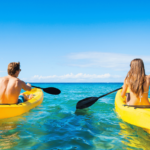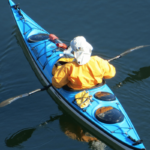Embarking on water adventures in a canoe is an exhilarating experience, but the threat of capsizing can dampen the spirit of any paddler. Whether you’re a seasoned canoeist or a newcomer to the waters, the stability of your vessel is paramount. This guide will introduce you to crafting a canoe stabilizer, a crucial addition to enhance your canoe’s steadiness and safety. Dive into the steps and tips that will transform your canoeing experience, ensuring you stay afloat and enjoy every moment on the water.
Understanding Canoe Stabilizer Basics
At the heart of enhancing your canoe’s safety and performance lies the implementation of a canoe stabilizer. These stabilizers, often referred to as outriggers, are pivotal in minimizing the risk of capsizing, making them indispensable for both novices and seasoned paddlers alike. A canoe stabilizer extends outward from the canoe’s sides, providing a much-needed balance through additional buoyancy. This mechanism is particularly beneficial in choppy waters or when the canoe is heavily loaded.
The design and material of the stabilizer play crucial roles in its effectiveness. Typically made from durable, lightweight materials such as PVC, aluminum, or even inflatable options, stabilizers must offer the perfect balance between being unobtrusive and providing significant stability. The choice between a fixed or removable stabilizer depends on the paddler’s needs and the specific conditions they anticipate encountering. Flexibility in adjustment can be a key feature for those who paddle in a variety of water conditions.
While the primary function of a stabilizer is to prevent capsizing, it also aids in improving the canoe’s trackability and maneuverability. This makes stabilizers not only a safety feature but also a performance enhancer, allowing paddlers to focus on their technique and enjoy their journey without the constant fear of tipping over.
Choosing the Right Stabilizer for Your Canoe
Selecting the appropriate stabilizer requires understanding your canoe’s specific needs and your paddling environment. Factors such as the canoe’s width, the weight it typically carries, and the water conditions you’ll be navigating are crucial considerations. A well-chosen stabilizer will not only make your canoe safer but also more enjoyable to paddle.
| Feature | Benefit | Material Options |
|---|---|---|
| Additional Buoyancy | Improves stability | PVC, Aluminum, Inflatable |
| Adjustability | Adaptable to various conditions | Fixed, Removable |
| Lightweight | Minimal impact on performance | Aluminum, Inflatable |
| Durability | Long-lasting, withstands rough conditions | PVC, Aluminum |
Choosing the Right Materials
When constructing a canoe stabilizer, selecting the appropriate materials is crucial for ensuring both safety and performance. The choice of materials impacts not only the durability and functionality of the stabilizer but also its weight and ease of installation. Lightweight materials such as polyethylene foam or PVC are popular choices due to their buoyancy and resistance to water damage. For the structure, aluminum and fiberglass offer strength without significantly increasing the weight.
It’s essential to consider the environment in which the canoe will be used. For rough waters, materials that offer higher durability and impact resistance are preferable. Conversely, for calm lakes or rivers, lighter materials that provide sufficient stabilization without hindering speed may be more suitable. Balancing these factors will help you create a stabilizer that enhances the canoe’s safety and performance.
Moreover, sustainability and environmental impact are becoming increasingly important. Opting for eco-friendly materials can help reduce the ecological footprint of your canoeing adventures. Whether for leisure or competitive use, the right materials will make all the difference in your canoe stabilizer’s effectiveness.
| Material | Pros | Cons |
|---|---|---|
| Polyethylene Foam | Lightweight, buoyant | Less durable than other materials |
| PVC | Water-resistant, easy to shape | Can be heavy in larger sizes |
| Aluminum | Strong, lightweight | More expensive, requires careful maintenance |
| Fiberglass | Durable, good impact resistance | Can be costly and complex to repair |
| Eco-friendly options | Reduce ecological footprint | May have higher upfront costs |
Understanding Material Characteristics
Each material used in the construction of a canoe stabilizer brings its unique set of characteristics. Knowing these can significantly aid in making an informed decision. For instance, the buoyancy of polyethylene foam makes it an excellent choice for the flotation aspect of the stabilizer, while the strength and lightness of aluminum make it ideal for the frame. Assessing the trade-offs between durability, weight, cost, and environmental impact is essential for selecting the right materials for your canoe stabilizer project.
Deep Dive into Material Selection
In delving deeper into material selection, it’s crucial to weigh the specific needs of your canoeing activities against the properties of potential materials. For competitive canoeing, where speed and maneuverability are paramount, choosing materials that offer the best balance between weight and strength becomes a priority. Leisure paddlers, on the other hand, might prioritize durability and ease of maintenance. Understanding the nuances of each material’s properties allows for a customized approach to building a canoe stabilizer that meets precise needs and preferences.
Designing Your Canoe Stabilizer
When embarking on the journey to enhance both the safety and performance of your canoe through a stabilizer, the design phase stands as the cornerstone of your project. This process involves understanding the dynamics of your canoe, the weight distribution, and how you intend to use it. Whether you are navigating calm lakes or tackling more turbulent waters, the design of your stabilizer should cater to these conditions.
The first step in designing your canoe stabilizer is to decide on the material. Common choices include PVC pipes, foam blocks, or inflatable pontoons. Each material offers its own balance of durability, buoyancy, and weight, affecting the overall performance of your canoe. For instance, PVC pipes are renowned for their resilience and ease of attachment, making them a popular choice among DIY enthusiasts.
Next, consider the dimensions of your stabilizer. The length and width of the stabilizers will directly influence the stability and maneuverability of your canoe. A longer stabilizer provides more stability but can make paddling more challenging, while a shorter one may not offer enough buoyancy to counterbalance the canoe’s weight. Therefore, finding the right balance based on your canoe’s size and your paddling environment is crucial.
Finally, attachment methods play a critical role in the design of your canoe stabilizer. Securely attaching your stabilizer to the canoe ensures it remains effective and safe under various conditions. Options include clamps, screws, or even custom-made brackets, depending on the design and materials you have chosen.
| Material | Pros | Cons |
|---|---|---|
| PVC Pipes | Durable, Easy to attach | Can be heavy |
| Foam Blocks | Lightweight, Good buoyancy | Less durable |
| Inflatable Pontoons | High buoyancy, Portable | Can be punctured |
| Wood | Eco-friendly, Aesthetic | Requires maintenance |
| Aluminum | Lightweight, Rust-resistant | More expensive |
Designing a canoe stabilizer is not just about enhancing the boat’s performance; it’s also about tailoring the experience to your specific needs. Whether you prioritize stability for fishing or maneuverability for adventure, understanding the materials, dimensions, and attachment methods will guide you towards creating a stabilizer that complements your canoeing endeavors. Remember, the ultimate goal is to enjoy a safer and more enjoyable paddling experience, and a well-designed canoe stabilizer is a significant step in that direction.
Step-by-Step Assembly Guide
Creating a canoe stabilizer from scratch is a rewarding project that enhances both the safety and performance of your canoe. With the right materials and a bit of elbow grease, you can construct a stabilizer that will make your canoeing adventures more enjoyable and secure. The following steps will guide you through the process of assembling your canoe stabilizer.
First, gather all necessary materials. You will need PVC pipes, foam flotation devices, and durable straps. Begin by cutting the PVC pipes to the required length to span the width of your canoe. This will serve as the skeleton of your stabilizer. Next, securely attach the foam flotation devices to each end of the PVC pipes. These will act as the actual stabilizers, providing the buoyancy needed to keep your canoe upright and stable. Ensure that the flotation devices are firmly attached to endure the rigors of use.
Once the basic structure is assembled, attach the stabilizer to your canoe using the durable straps. Position the stabilizer so it’s perpendicular to the canoe, and adjust the straps until the setup is snug and secure. This attachment process is crucial as it determines how effectively the stabilizer will perform. Test the stability in a safe, shallow area before heading out to deeper waters.
To ensure a successful assembly, follow these items:
- Measure the width of your canoe accurately to cut the PVC pipes to the correct size.
- Choose high-quality, waterproof materials to ensure longevity.
- Test the buoyancy of your foam flotation devices in advance.
- Tighten all attachments securely to prevent any shifts while in use.
- Regularly inspect and maintain your stabilizer for optimal performance.
Assembling a canoe stabilizer is a straightforward process that can significantly enhance your canoeing experience. By following these steps and tips, you’ll be well on your way to safer, more enjoyable adventures on the water. Remember, the most important aspect of this project is safety, so take your time and ensure everything is assembled correctly and securely.
Maintenance and Safety Tips
Maintaining your canoe stabilizer is crucial for ensuring both the safety and longevity of your equipment. Regular checks and maintenance can significantly enhance the performance of your canoe, making your adventures on the water both enjoyable and secure. It is essential to inspect your stabilizer for any signs of wear and tear before and after each use. Look for cracks, deterioration, or any other damage that might affect its functionality. Paying attention to these details can prevent accidents and ensure that your stabilizer performs effectively.
Another important aspect of maintenance is proper storage. When not in use, your canoe stabilizer should be stored in a cool, dry place away from direct sunlight. UV rays can degrade the materials over time, reducing the stabilizer’s effectiveness and safety. Also, make sure to rinse your stabilizer with fresh water after each use, especially if you’ve been in saltwater, to prevent corrosion and buildup of salt crystals. After cleaning, allow it to dry completely before storage to prevent mold and mildew growth.
Safety is paramount when using a canoe stabilizer. Always wear a life jacket or personal flotation device while on the water, regardless of your swimming skills. It’s also wise to carry a whistle or other sound-producing device to signal for help in case of emergency. Lastly, never exceed the weight limit recommended by the manufacturer, as doing so can compromise the stabilizer’s performance and your safety.
Regular Inspection and Care Routine
Adopting a regular inspection and care routine for your canoe stabilizer is vital. This routine should include checking all fastenings for tightness, inspecting inflatable components for leaks, and ensuring that the attachment points on your canoe are secure and undamaged. This proactive approach will help you catch potential issues before they become serious problems, allowing for a safer and more enjoyable paddling experience.
| Maintenance Task | Frequency | Importance |
|---|---|---|
| Inspection for damage | Before and after use | High |
| Cleaning with fresh water | After use in saltwater | High |
| Checking fastenings | Every outing | Medium |
| Storage in a dry location | After each use | High |
| UV protection treatment | Annually | Medium |
Maintaining your canoe stabilizer is not just about prolonging its lifespan; it’s about ensuring your safety and enhancing your performance on the water. By adopting a routine of regular inspection, proper cleaning, and careful storage, you can enjoy countless hours of paddling adventures. Always remember, safety comes first; wearing a life jacket and adhering to the weight limits are non-negotiable practices for a safe journey. Let these maintenance and safety tips guide you in keeping your canoe stabilizer in top condition, ready for your next water expedition.
With these practices in place, you can rest assured that your canoe stabilizer will serve you well for many outings to come. Safety and maintenance go hand in hand, forming the foundation of enjoyable and worry-free canoeing experiences. Keep these tips in mind, and you’re set for a great time on the water.
I’m Adam Reynolds, a dedicated sports writer with a passion for both competitive gaming and betting. In my mid-thirties, I dive deep into the world of sports, providing insightful analyses and strategies to help readers make informed betting decisions. My experience spans various sporting events, where I blend my love for the game with a keen eye for betting trends. Whether I’m dissecting game tactics or offering betting tips, I aim to deliver content that is both engaging and practical. Join me as we explore the exciting intersection of sports and betting together.





